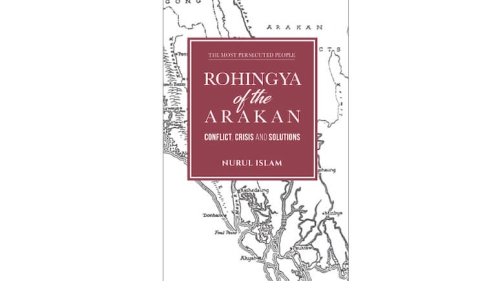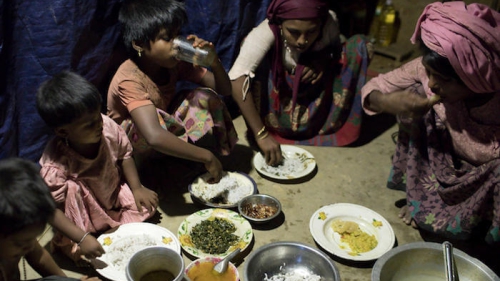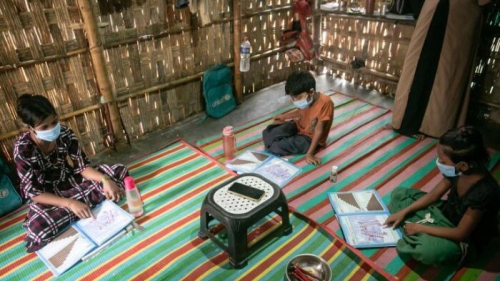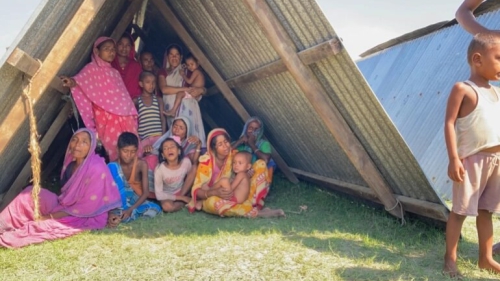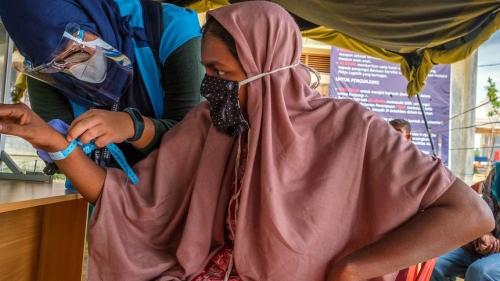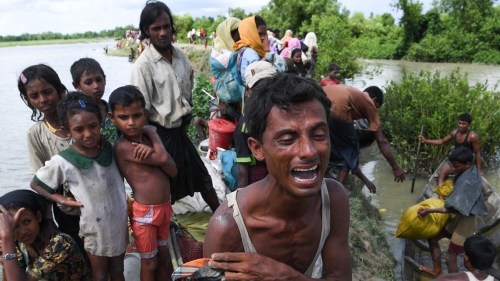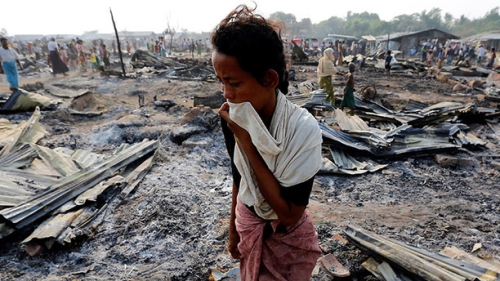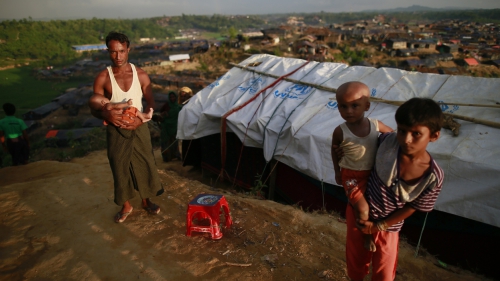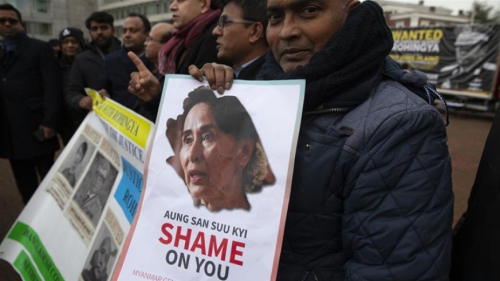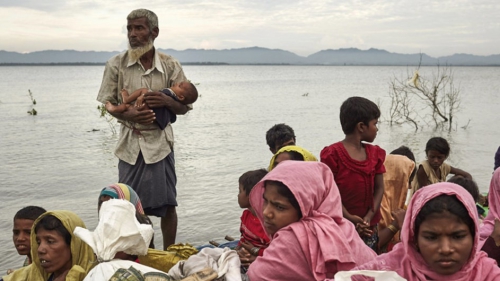The Rohingya Question - Part 2
 |
The Rohingya Identity
It has been sometimes argued, especially amongst the anti-Rohingya demagogues, and the numerous suppositions which some biased scholars have made, that since the designation "Rohingya" did not appear in the Baxter Report and some of the papers associated with it in the National Archives and the British Library in the UK, it was an invented term used by the Arakanese Muslims to claim ethnic status in Burma. In so doing, as if suffering from selective amnesia, they forget to state that the term -Rakhine- was not used for the Arakanese Buddhists in many such reports either. Instead, we find the use of the words like -Mugs- (see, e.g., Charles Paton-s work) and -Magh- to refer to the Rakhine Buddhists. The Rohingya Muslims of Arakan were similarly referred as Arakanese Musselmans and Mohamedans.
British reports have often mentioned Muslims in various parts of India as Mohamedans, Mahommedans and Musselmans. In some reports, all those terms were used interchangeably. Similar kinds of names were also used by the colonial administration for other communities, which served either their policies or whims.
There are numerous examples in our world where even the same place is called by different names by different communities. For example, Bangladesh is commonly known as Manjala (Mangala) in Chinese. In ancient times, Bangladesh was known as Banga, which later came to be known as Bangala by Arab and Persian geographers.
In the ancient times the land of Arakan was known as Arakan Desh, which in the pre-Burman annexation period, in the writings of writers and poets of Arakan and Chittagong, like Quazi Daulat, Mardan, Shamser Ali, Quraishi Magan, Alaol, Ainuddin, Abdul Ghani and others, came to be referred to as -Roshang-, -Roshanga-, -Roshango Shar-, and -Roshango Desh-. However, in the local tongue Arakan was called Rohang by its Muslim population and as Rakkhapura or Rakhinepray or Rakhine Pye by its local Buddhists. In the Rennell-s map (1771 CE), Arakan is shown as -Roshawn-. The Tripura Chronicle Rajmala mentions it as -Roshang-. The Chakmas and Saks of the 18th century called the country -Roang-. [Note that words which sound like -sha- are often changed to -ha- by many people living in adjacent areas north and south of the Naaf River demarcating today-s Rakhine state from southern part of Chittagong in Bangladesh. That is, Roshang and Rohang mean the same thing.]
To most Bengali speaking people America and Britain are known as Markin and Bilat in Bangla. The British colonizers also anglicized many of the local names of towns and cities. Chatga, for instance, came to be known as Chittagong in British records. Sri Lanka, which was known by ancient Greek geographers as Taprobane and as Serendib (or Saran Dip) by Arab geographers, came to be known as Ceilo by the Portuguese when they arrived on the island in 1505, which was transliterated into English as Ceylon.
Can such use of altered forms of the name of a country, place or people by outsiders obliterate their original names? Surely, not! What is important here is to realize that such changes or uses of nomenclature do not and cannot alter how the people identify or feel about themselves and their places.
Calling a people based on the region or district that they come from is a common practice in many parts of south Asia. For example, a person from Sylhet is commonly known as a Sylheti (speaking a dialect which is not quite understood by most Bangalis); a person who is from Faridpur is called Faridpuri and a person from Dhaka is called Dhakaiya. And yet, the British records did not make that distinction between these peoples. They were all lumped as Bengalis in spite of their colloquial differences.
It is worth noting from the Baxter report that the British census records originally mentioned only religion, and that only much later they tried to classify people by any of the 40 races or ethnic groups for the entire Indian population. As to the classification by races in 1921 and 1931, the report says, "For these years the Indian constituent of the population is taken to be the number of persons who then returned themselves as belonging to one of the forty specified Indian races, or who were tabulated as "Indians of unspecified race" where their records though indefinite showed they belonged to an Indian race."
It is, thus, understandable why the British authority would rather classify the Rohingya Muslims under Bengali or Chittagonian race because of their cultural similarity with people living on the other side of the Naaf River. It is also obvious from the report that many of the inhabitants were concerned about the 'hidden' agenda of such census reporting, and did not feel comfortable in sharing such information about their race or origin.
So, the mere debate around why the Arakanese Muslims were not called Rohingya people in the Baxter report sounds like raising tempest over teapots.
As we have noted elsewhere there are other records, including British, which mention the name Rohingya. Consider, for instance, the account of the English surgeon to Embassy of Ava, Dr. Francis Buchanan (1762-1829 CE), who visited Burma decades before the British occupied the territory. He published his major work "A Comparative Vocabulary of Some of the Languages Spoken in the Burma Empire" in 1799, in the fifth volume of Asiatic Researches, which provides one of the first major Western surveys of the languages of Burma. What is more important is that his article provides important data on the ethno-cultural identities and identifications of the various population groups in the first half of Bodawpaya-s reign (1782-1819). He wrote, "I shall now add three dialects, spoken in the Burma Empire, but evidently derived from the language of the Hindu nation. The first is that spoken by the Mohammedans, who have long settled in Arakan, and who call themselves Rooinga, or natives of Arakan. The second dialect is that spoken by the Hindus of Arakan. I procured it from a Brahmen [Brahmin] and his attendants, who had been brought to Amarapura by the king-s eldest son, on his return from the conquest of Arakan. They call themselves Rossawn, and, for what reason I do not know, wanted to persuade me that theirs was the common language of Arakan. Both these tribes, by the real natives of Arakan, are called Kulaw Yakain, or stranger Arakan. The last dialect of the Hindustanee which I shall mention is that of a people called, by the Burmas, Aykobat, many of them are slaves at Amarapura. By one of them I was informed, that they had called themselves Banga; that formerly they had kings of their own; but that, in his father-s time, their kingdom had been overturned by the king of Munnypura [Manipur], who carried away a great part of the inhabitants to his residence. When that was taken last by the Burmas, which was about fifteen years ago, this man was one of the many captives who were brought to Ava. He said also, that Banga was seven days- journey south-west from Munnypura: it must, therefore, be on the frontiers of Bengal, and may, perhaps, be the country called in our maps Cashar [Cachar]." [Notes: 1. In the above account, the word Rohingya is spelled as Rooinga.. 2. Cachar district, part of the state of Assam in India, is located north-east of Sylhet in Bangladesh; it is located between the Indian state of Manipur and Bangladesh.]
Dr. Buchanan-s above statement is very revealing in that it shows that before the British occupied Arakan and the rest of Burma there were already Muslims living there who had identified themselves as the Rohingya, and that it was not an invented term. This observation squarely contradicts the current campaign by ultra-nationalist Rakhines and Burman racists that the Rohingyas settled in the Arakan only after the British occupation.
In his massive work - A Geographical, Statistical, and Historical Description of Hindostan and the Adjacent Countries in Two Volumes, published in London in 1820, Walter Hamilton wrote about Arakan (the Rakhine state), "The Moguls know this country by the name of Rakhang, and the Mahommedans, who have been long settled in the country, call themselves Rooinga, or the natives of Arracan."
Thus, we can draw the conclusion that before the British even entered Arakan, the Muslim inhabitants called themselves by that name and were known as such by others.
These revelations about the Rohingya people from Buchanan and Hamilton should not come as a surprise to any genuine researcher of Arakanese and Burmese history. Numerous research works have demonstrated that a substantial portion of Arakan-s Muslim population was made up of descendants of Muslims who had lived in Arakan for centuries.
In his first hand account of the Arakanese Muslims, Charles Paton, wrote, "The Musselman Sirdars generally speak good Hindustani, but the lower orders of that class, who speak a broken sort of Hindustani, are quite unintelligible to those who are not thoroughly acquainted with the jargon of the southern parts of the Chittagong district." It is not difficult to understand why the elites (Sirdars or Sardars) within the Arakanese Muslim society - the descendants of those attached to royalty and those in high offices - were more familiar with Hindustani, which is closer to Farsi, than the less educated cultivator class. Many of the forefathers of those elites came as the soldiers of generals Wali Khan and Sandi Khan who came to restore the kingdom of Nara-meik-hla in the early 15th century, and courtiers, ministers and administrators - as we shall see below - that later attached themselves with the Arakanese royalty in Mrohaung.
In his travelogue, the Augustine monk Friar Sebastian Manrique mentioned Arakanese king-s coronation ceremony in the early 17th century in which the parade was opened by Muslim cavalry unit of Rajputres from India, which was led by its cavalry leader.
Michael Charney in his doctoral dissertation (under the supervision of Professor Juan Cole of the University of Michigan) mentions about the emergence of Muslim -cultivator- class in Arakan from at least the 17th century when large number of Bengalis were kidnapped by Maghs and Portuguese slave traders to work in the Kaladan valley. Quoting Manrique, he says that from 1622 to 1634, some 42,000 Bengali captives were brought in by the Portuguese pirates. By 1630, there were probably 11,000 Bengali families living in rural areas of Danra-waddy. The actual number is, however, significantly higher since there were also royal-sponsored campaigns to bring Bengalis as captives. Charney estimates that between 1617 and 1666, the total number of those Bengali captives could be 147,000. He also mentions about Bengali captives brought from Chittagong to Arakan as late as 1723 during the reign of Sanda-wizaya-raza. Those captives were called Kala-douns in the Arakanese chronicles, "who were then donated as pagoda-slaves in the ordination halls and monasteries, including the Maha-muni shrine complex."
As noted by Professor Moshe Yegar of the Hebrew University of Jerusalem, the capture and enslavement of prisoners was one of the most lucrative types of plunder of Bengal by joint Magh and Portuguese pirates. In his article, "The Crescent in the Arakan", Yegar wrote, "Half the prisoners taken by the Portuguese and all the artisans among them were given to the king; the rest were sold on market or forced to settle in the villages near Mrohaung. A considerable number of these captives were Muslims." It is not difficult to surmise that those abducted slaves and their descendants would identify themselves as the Rohingya.
Charney writes, "It is not surprising that in the late 1770s, as observers based in Chittagong explained, -Almost three-fourths of the inhabitants of Rekheng [Danra-waddy] are said to be natives of Bengal, or descendants of such... In short, despite the lack of complete data, it is still apparent that the demographic contribution of Bengali captives to Danra-waddy-s population is considerable."
Charles Paton, similarly, mentioned the reason why the Rohingya Muslims were traditionally employed in farming: "The Mugs being particularly fond of hunting and fishing, do not make such good farmers as the Musselmans; however, as Banias and shop-keepers, they surpass the Bengalis in cunning, and, on all occasions try, and very often successfully, to overreach their customers: stealing is a predominant evil amongst them ... " The Arakanese (Rohingya) Muslims and Hindus, as children of the indigenous people of the soil, were mostly involved in wet farming since time immemorial, a tradition which they retained before and after the British moved into Arakan.
Charney also mentions about the existence of a small group of Muslims dating as far back as the 9th century. He also cites Arakan traditions which hold that ship-wrecked Muslims had settled in Arakan as early as the 8th century. The Muslim population grew significantly with the Mrauk-U dynasty. Even Muslim mercenaries were brought in to fight in special campaign or to solve special problems within Arakan. He writes, "It is unlikely that these mercenaries had no influence in terms of advertising Islam to the Arakanese. After all, the Muslim mercenaries who helped restore Nara-meik-hla to his throne seem to have built the Santikan mosque in Mrauk-U in about 1430. There was also certainly a small Muslim presence among the intermediary service elites in the royal city during the early Mrauk-U period... At the beginning of the seventeenth century, there were many Muslims in the Arakanese court, including a Turkish courtier ... who seems to have become a kind of royal adviser."
There was also a small, but wealthy and influential community of Muslim traders in Arakan. "Even higher status Muslims arrived as political refugees from Bengal with Shah Shuja in the mid-seventeenth century. Together, Muslims in the royal city formed a special social group with a privileged and unique socio-political role than their rural counterparts enjoyed, with different connections to the Muslim world," notes Charney. Suffice it to say that before Bodawpaya-s invasion of Arakan, Arakanese Muslims (also known as the Rohingya) were employed in various professions: from high ranking courtiers in the capital city to non-elites and agriculturalists into the countryside.
Quoting British census, Charney says that in 1891 there were 126,586 Muslims in Arakan (most of whom were concentrated in Danra-Waddy, wherein sat the capital), comprising roughly 19% of the total population. This figure should not come as a surprise given the fact that in the 1830s, at least 30% of Arakan-s general population was Muslim. For the original number to increase to the 1891 number, only a growth rate of 2.24% was necessary. This annual growth rate is below what was prevalent in those days amongst the Muslim population in Bengal and Arakan suggesting rather strongly that to grow to that size it did not require an influx from outside.
As I have pointed out in an earlier work on demography in Arakan, a rational basis for understanding the size of the Rohingya population in Burma during the British period lies in Charles Paton-s data when the East India Company colonized Arakan. As the Sub-commissioner in Aracan (Arakan), he was able to estimate the population soon after Arakan came under British rule. He said, "The population of Aracan and its dependencies, Ramree, Cheduba, and Sandoway, does not, at present, exceed a hundred thousand souls, and may be classed as follows: Mugs, six-tenths; Musselmans, three-tenths; Burmese, one-tenth; total, 100,000 souls."
The questions that an unbiased researcher, therefore, has to ask are: what happened to those 30,000 Arakanese Muslims whom Paton called Musselmans? During the British period in 1871, 1881, 1891, 1901, 1911, 1921, 1931 and 1941 or thereafter what was the size of their population?
Ignoring such obvious signs and records of presence, many Rohingya-deniers continue to say that the Rohingyas are not an ethnic group in Myanmar. And in recent months we have witnessed quite a few state-managed demonstrations, which even included highly politicized pro-government, ultra-racist monks carrying placards that demanded that the 1982 constitution - responsible for making the Rohingya people stateless - should be strictly followed by the government so that they can be removed from Myanmar. Claims and demands of this kind are symptomatic of the depth of racism and bigotry that has penetrated the Buddhist society inside Myanmar. Consequently, the latest genocidal campaign to ethnically cleanse the Rohingya which began in June of 2012 has already succeeded in uprooting more than a hundred thousand Rohingya people who are now forced to live in concentration camps, unless they choose to settle for a life of uncertainty elsewhere. They cannot go out to fetch livelihood. As al-Jazeera-s documentary film -The Hidden Genocide- revealed, they are starving to death. It is a slow death camp for them!
 |
Questions on Ethnicity
So, what is ethnicity? Can the minority Rohingya qualify as an ethnic group?
Ethnicity has been a debated topic and there is no single definition or theory of how ethnic groups are formed. According to John Hutchinson and Anthony Smith, the term "ethnicity" is relatively new - first appearing in the Oxford English Dictionary in 1953, but its English origins are connected to the term "ethnic," which has been in use since the middle ages. The true origins of "ethnic" have been traced back to Greece and the term ethnos, which was used in reference to band, tribe, race, a people, or a swarm. Thus, it often refers to shared heritage, culture, group history, language and beliefs. An ethnic group or ethnicity is a population of human beings whose members identify with each other, on the basis of a real or a presumed common identity - whether that be in relation to language, culture, religion, group history or heritage.
According to Timothy Baumann, "The underlying truth of ethnicity is that it is a product of self and group identity that is formed in extrinsic/intrinsic contexts and social interaction. Ethnicity is not the same as nor equal to culture. Ethnicity is in part the symbolic representations of an individual or a group that are produced, reproduced, and transformed over time."
In more recent colonial and immigrant history, the term "ethnic" falls under the dichotomy of "Us" and "Them." The "Us," the majority, are viewed as non-ethnics and the "Them," new immigrants or minorities, as ethnic. Thus, e.g., the Hispanics in the USA are an ethnic group, although racially they may be White Caucasians. The Afro-Americans are both an ethnic group and a race that is different than the majority Whites in the USA.
As to the Rohingya identity, it is worth noting the views of Professor Moshe Yegar, an area specialist on Burma. He wrote in an article "The Crescent in Arakan", "It is not possible today to differentiate among the various Muslim groups or between them and the Buddhist Arakanese, among whom they live. The Arakanese Muslims are Sunnites despite the preponderance of some Shitte traditions among them. Under their influence many Muslim customs spread to the Buddhists, such as for example a veil for the women similar to the purdah. Today the Arakanese Muslims call themselves Rohingya or Roewengyah. This name is used more by the Muslims of North Arakan (Mayu region) where most of the Muslims- approximately 300000- are concentrated, than by those living near Akyab. Writers and poets appeared amongst the Arakanese Muslims, especially during the fifteenth to eighteenth centuries and there were even some Muslim court poets at the courts of the Arakanese kings. These poets and writers wrote in Persian and Arabic or in the mixed language, Rohinga, which they developed among themselves and which was a mixture of Bengali, Urdu, and Arakanese. This language is not as widespread today as it was in the past and has been largely replaced by Burmese and Arakanese. These artists also developed the art of calligraphy. Some manuscripts have been preserved but have not yet been scientifically examined. Miniature painting in Mogul style also flourished in Arakan during this period. The Muslims who came to Arakan brought with them Arab, Indian, and especially Bengalese music and musical instruments. Persian songs are sung by Arakanese Muslims to this day. That is how the Rohingas preserved their own heritage from the impact of the Buddhist environments not only as far as their religion is concerned but also in some aspects of their culture."
From the above discussion, we can conclude that the Rohingyas, who are distinct by language, culture and religion from the rest of the peoples of Myanmar, and have a shared history and group identification, are an ethnic group by any definition. This fact has been duly recognized in the encyclopedia where they are named as an ethnic group.
The Rohingya people identify themselves by this name, and no one should have the audacity to deny them that right of self-identification. After all, every nation has the right to call itself by whatever name it chooses. As such, the non-mention of the term -Rohingya- in some British records (and not all) cannot be the criterion to deny the Rohingya identity.
Final Words
From the analysis of the data and records in the British colonial period, it is obvious that the root of the Arakanese Muslims, who identify themselves as the Rohingya, is much deeper than what the anti-Rohingya propagandists have claimed. Contrary to such popular claims and myths made and packaged by the Myanmar government and its ultra-racist supporters and executioners within the broader Rakhine and Myanmar Buddhist society, the Baxter report said, "There was an Arakanese Muslim community settled so long in Akyab (Sittwe) District that it had for all intents and purposes to be regarded as an indigenous race." (Paragraph 7) This theme of the "indigenous" nature of Muslims permanently resident in Arakan is repeated in the Report several times. The Report further notes, "Unlike Indian immigrants in general in other parts of Burma who commonly spend periods of three years or thereabouts in the country without returning home, the bulk of the Chittagonian immigrants in Arakan who come to reap the paddy crop go back to Chittagong when the harvesting operations are over. The nearness of their homes and the small amount of money required for the journey make this possible."
These findings should not come as a surprise since unbiased research works of area specialists have amply demonstrated that the Rohingyas are descendants of the original inhabitants of Arakan. As the subjects of the ancient Chandra dynasty in the Vaisali Kingdom, which included Chittagong and Arakan, their settlement predates those of the Rakhines by few centuries. Additionally, before even the British occupied the territory, those Muslim inhabitants were identified by the name Rohingya (Rooinga). It was neither a British-era concoction nor an invention in independent Burma. Denying this piece of history by anyone is simply absurd, and only goes on to show one-s deplorable racism and bigotry!
One of the most egregious crimes is to deny the right of a people to define itself. For years, the chauvinist Buddhists of the Rakhine state and Myanmar, however, have been doing precisely that crime to deny the -frontier- history and culture of the Rohingya people through their racist writings and propaganda simply because of their distinct race and religion. Buried in that unfathomable prejudice and colossal records of inhumanity is the mere realization that ethnicity is a feudal and an alien concept in our time.
Every human being has a right to citizenship in our time. The Rohingya people cannot be and should not be treated as aliens in the country where they and their forefathers were born.
Epilogue
In today-s Myanmar denials of the Muslim heritage and culture, their dexterous roles in the independent Arakan (today-s Rakhine state) under the Mrauk-U dynasty (1430-1784) have become staples of a toxic Myanmarism that is criminal, divisive and murderous. Not only are the Muslims killed and their women raped, and their homes, businesses, schools, shrines and mosques destroyed, even the towns and villages bearing Muslim names are changed to Rakhine names to erase their Muslim root.
No less problematic are the attitudes of and roles played by some of the pseudo-scholars and academics who like Julius Streicher of the Hitler-s Nazi era are selling the poison pills of racism, ultra-nationalism and bigotry to deny the Rohingya people their basic human rights as rightful citizens in Myanmar enjoying equality. Puffed up in obnoxious arrogance and a criminal vision of a race-and-religion-purified Rakhine state minus the Muslims, they twist and distort facts, and deny the existence of the Rohingya people before the British moved into Burma.
As if suffering from a serious case of selective amnesia, these Buddhist zealots and their agents - purporting sometimes to be researchers - forget to educate their cadre that the Arakanese Muslims were probably a majority in the last years of independent Arakan before Bodawpaya-s invasion. Rather than explaining what had happened to those Arakanese Muslims of the pre-Bodawpaya era, they manufacture ludicrous theories about Muslim influx. By so doing, they try to deceive others and create an environment of intolerance against the Rohingya Muslims.
As I have noted elsewhere, the authors of this revisionist history to deny citizenship rights are some of the Rakhine ultra-racists and pseudo-scholars like (late) Aye Kyaw and Aye Chan, who, interestingly, did not and do not have any bites of conscience to become naturalized citizens in the USA. In our world there are hardly such dastardly examples of moral bankruptcy by academics! The sad fact is their willful distortions of facts and their absolutely evil thesis about the so-called (Rohingya) Influx Virus has been accepted as a Rakhine -Mein Kampf- and interpreted as a green signal to exterminate the Rohingya and other Muslim minorities in a frontier territory that is anything but homogeneous.
Since June of this year, in a very premeditated manner with full support of the government forces, the local politicians and monks, towns after towns and villages after villages with Muslim population have simply been burned down and Muslims butchered to death, while the racist Rakhine Buddhists gave a hero-s welcome to Aye Chan as their savior. Government denies that it-s an ethnic cleansing campaign. In October, 2012, exasperated by Myanmar denialism, Human Rights Watch had to publish a satellite photo showing most of the Muslim quarter of a sizable town, Kyak Pyu, burned to the ground.
In his evaluation of the treatment of the Rohingya people inside Myanmar, Professor William Schabas, the former president of the International Association of Genocide Scholars, says: "When you see measures preventing births, trying to deny the identity of the people, hoping to see that they really are eventually, that they no longer exist; denying their history, denying the legitimacy of their right to live where they live, these are all warning signs that mean it's not frivolous to envisage the use of the term genocide."
In my cautious evaluation of the case, I have also reached the same conclusion. I am sure Daniel Jonah Goldhagen would also agree. And there are many other scholars and individuals who concur that what the Rohingyas are facing today is a genocidal campaign to eliminate them from Myanmar. As I have noted earlier, this eliminationist campaign has become a national project with willing participation from top to bottom with closing of ranks among local and national governments, pro and anti-government Buddhist monks, junta apologists and pro-democracy activists, President Thein Sein and Aung San Suu Kyi. They are all united to deny the apparently undeniable fact that an old fashioned genocidal program is taking place against Rohingya minority and other Muslims.
Many outsiders are simply perplexed by the role of Myanmar-s so-called Buddhist Talibans, i.e., the militant Buddhist monks. For years, Buddhism has skipped the kind of scrutiny that is commonly reserved for other religions. People in the West have held a romantic view about Buddhism, imagining, rather mistakenly, that it is a non-violent religion. Forgotten in that make-belief is centuries of Buddhist violence against others from one part of Asia to another, where millions were killed ruthlessly. While compassion is considered central to Buddhist faith, the sad fact is most Buddhists have been failing on this yardstick since the days of Emperor Ashoka. Worse yet, most of them are unaware of their racism and bigotry. And a study of the history of Buddhist Burma is sufficient to reveal that it has been a hellish den of prejudice and intolerance for more than a millennium.
In the context of Bangladesh and Arakan, for centuries the southern Bengal (today-s Bangladesh) was ravaged and devastated by Buddhist terrorism when hundreds of thousands of Bengali Muslims and Hindus were forcibly abducted, their palms pierced and enslaved to work inside Arakan. It is not difficult to guess how many Bengalis were killed and women raped by those marauding Buddhist Maghs (Rakhines). Many of those abducted did not even make it alive at the end of their abduction. And the greatest tragedy is while the descendants of former slaves from Africa to the Americas have been recognized as citizens in those territories of their captivity, the descendants of those Bengalis enslaved in Arakan and Burma continue to be denied their rights to citizenship. We hardly have a parallel of that travesty of fairness and justice in our time!
To some historians, the worsening of Muslim-Buddhist relationship originated in 1942 when Japan occupied Burma. But the truth is: it is much older. As Charney has rightly noted, Muslim-Buddhist relationship took a downward trend since Shah Shuja-s visit to Arakan in 1660 when he was betrayed by the Arakanese ruler and killed. Some of the latter rulers, encouraged by monks, tried a Buddhicization of the kingdom. By the end of the 18th century some groups in Arakanese Buddhist society had begun to call for social exclusion (apartheid) on the basis of popular religious affiliation.
With Bodawpaya-s annexation of Arakan in 1784, the relationship simply worsened. From 1787, the "Rakhine Arei-taw-poun" (popularly known as the "Danra-waddy Arei-taw-poun") composed by a Buddhist missionary (known as sasana-pru or -propagator of religion-) monk based in San-twei, emerged as a highly pro-Buddhist and anti-Muslim epic. Among other things, it cast aspersions on Muslims and warned Arakanese kings that the -dangers- of the Muslims posed to the -Arakanese- way of life. "The Arakanese are Maramas (Burmans), the text suggested. In the 19th century, these sentiments began to influence the popular notions of group identification," Charney noted.
Many of the today-s Buddhist monks in Myanmar are spiritual disciples of that 18th century highly chauvinist Rakhine monk. It is no accident that they are the greatest backers of expulsion and exclusion, and have been the catalysts within the broader society inciting intolerance against and providing moral justification for extermination of Muslims. Within the Buddhist society they have always played a major role, since every Buddhist male must embrace monkhood at least once in his lifetime. It would be nave to assume that extremist Buddhist monk Wirathu, who heads the Burmese monks and is leading the crusade, is an exception in the racist Burmese society. He spent more than 10 years in jail for his direct involvement in clashes between Buddhists and Muslims in 2001 in the city of Mandalay. He was released late last year as part of the new government's round of amnesties, and soon visited by Aung Thaung, a man known to be close to former dictator Than Shwe. So, with the racist monks holding the leash, and ties with the government, it is highly unlikely that Buddhist violence against the minority Muslims, esp. the Rohingya will stop anytime soon.
Is there a way out of these Buddhist acts of inhumanity which are soiling the image of Buddhism? Can our generation tolerate another genocide?
The sad reality is prejudice dies hard. For the Buddhists in Myanmar, esp. in the Rakhine state, it would take years of de-programming to shun old myths and prejudices about the -other- peoples, esp. the Rohingyas who have no less of a claim to citizenship than them. However, the government can accelerate this process of learning, if it is sincere about moving forward. It must also rein on the racist elements so that they cannot have an abrasive effect on racial-religious relationship. It must learn like many others in our world who have learned through their bitter experiences that racism and bigotry are not acceptable in our world which is increasingly becoming globalized and diverse. The sooner the better!
*****
Dr Habib Siddiqui has authored 10 books. His latest book - Devotional Stories - is now available from A.S. Noordeen, Kuala Lumpur, Malaysia.







